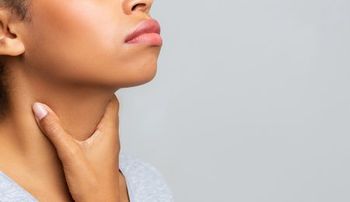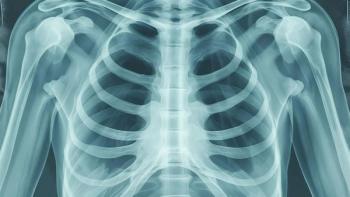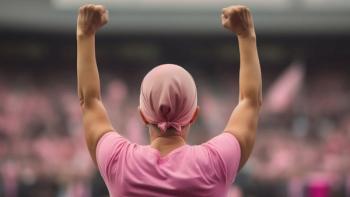
- CURE Fall 2024
- Volume 23
- Issue 3
Making Dynamic Decisions as AYAs During the Cancer Treatment Process
During the cancer treatment process, it's important for adolescents and young adults to balance independence while seeking support from loved ones.
At 23 years old in 2011, Stacy Leung achieved two major milestones: moving to Baltimore from Philadelphia and starting a career at Morgan Stanley. However, when she received a diagnosis of stage 2 triple-negative breast cancer, the momentum in her life temporarily came to a stop.
When deciding on treatment options, Leung’s mother told her to follow whatever the doctors said to do. Trusting her care team, she underwent a lumpectomy to remove the tumor and surrounding breast tissue, chemotherapy and radiation, but not a mastectomy (surgical removal of one or both breasts) or any breast reconstruction. Before the treatment began, Leung also met with a fertility doctor to discuss fertility preservation.
Receiving a diagnosis of cancer at a young age means Leung is in the adolescent and young adult (AYA) category. Patients with cancer in this age group typically experience unique challenges at this earlier stage in life. During this time of many unknowns, AYAs must navigate the treatment decision-making process, which may be an added stressor for patients and their families. Nevertheless, Leung faced this match of treatment decision-making a second time.
Twelve years later in 2023, as Leung prepared for her wedding, a routine MRI scan for imaging and surveillance showed that she had entirely new chapter of her life, her diagnosis came as a shock to her and her fiance.
“I was at a point where I was working my dress [already] and I’m like, ‘OK, this is what’s happening,’” Leung explains. “Having the unknown was the hardest part. Once I had a game plan, it was fine because I knew exactly what the moves were and what was going to happen.”
Now working as a physician’s assistant in the surgery department of a Philadelphia hospital, Leung knew precisely what she planned to do surgery wise. She underwent a bilateral mastectomy to remove both of her breasts. However, choosing the type of cosmetic procedure to receive following the mastectomy was an unexpected challenge. A passionate boxer at her local Muay Thai gym, Leung did not want to give up her chance of being able to spar again. She spoke extensively with her plastic and breast surgeons to advocate for her best quality of life and being able to do what she loves.
“I wanted to be able to hit pads, be able to spar and have my peak mobility. I also wanted the quickest recovery," Leung says. "Initially, I was gonna go in with just flat surgery and not have any reconstruction done. But my cousin said, ‘You should probably consider having something done because you don’t know if it’s going to impact you later in life or your mental health [regarding your femininity].’”
After some consideration, Leung decided on bilateral implants, although her plastic surgeon disagreed and tried convincing her to pursue a flat or other cosmetic options. Nevertheless, she stood her ground after having done her research and ultimately made the decision that best suited her body and lifestyle.
Treatment Decision-Making at a Young Age
The age range for AYAs with cancer is between 15 and 39 years old, according to the National Cancer Institute. Although the range is significant, AYAs account for approximately 4% of all cancer diagnoses. In 2024, the majority of cancer types within this patient population include breast, thyroid, testicular cancers and melanoma of the skin, statistics from the National Cancer Institute state. A growing number of cancer centers are establishing AYA programs to ensure that tailored services such as fertility planning, job counseling and psychological support are available.
For AYAs who have received diagnoses of cancer, it can be an overwhelming and challenging time. To start, having a close-knit support system is essential, says Dr. Michael Roth, co-director of the Adolescent and Young Adult Program at The University of Texas MD Anderson Cancer Center in Houston. Specifically, finding a provider and care team that feels comfortable and trustworthy is important because a lot of time, effort and knowledge is shared, Roth explains.
Before making treatment decisions, taking notes at appointments and writing down questions ahead of time can help AYAs and their families through an intimidating time, Roth says. Stages in AYAs’ lives should be considered, he emphasizes, especially when deciding on a treatment.
“Highest on the list is what type of treatment will be best for [AYAs] and their cancer, and how to maximize cure rates and make sure there aren’t too many side effects, both short term and long term,” Roth says. “It’s also important to think of other areas of life that are relevant, whether [the patients] are in school, working, [if they are] in a relationship and [have] plans of family building.”
Considerations of quality of life and prospects should also be addressed with care teams before choosing a treatment, Roth says. Thinking about goals for care and personal life is significant during this stage, he notes.
“For every individual, they have the right to determine what is most important in their treatment and their lives, during and after treatment,” Roth adds. “I want [AYAs] to be proud of themselves as they go through this process and this journey. This is equivalent to working five jobs, trying to be an AYA and just living life. Know that the team is here to support you, whether it’s your family, friends or medical team — lean on others for support.”
'Focusing on Quality Over Quantity'
At 19 years old and right before her sophomore year at the University of Washington, Mia Sandino thought she sprained her knee — only to learn that she had a 2 1/2-inch benign tumor in her tibia, a bone in the shin. After meeting with an orthopedic surgeon, Sandino and her mom, Serena, were told there were two options: She could either miss school for an entire year and replace the tibia, knee and femur (thigh bone) with metal and a hinge joint or miss school for a few months and undergo a minimally invasive procedure to remove the tumor and fix her broken bone with bone cement.
Before making this tough decision, Sandino and her mom consulted the doctor, asking what option she would choose if her child were going through this process. Undergoing the minimally invasive procedure, Sandino’s doctor said, would be the option she would choose because of Sandino’s adamancy toward academics.
Sandino had her tumor removed five days after the meeting with her doctor. Yet, when the results returned, the pathology revealed that the back half of the tumor was stage 3 osteosarcoma, a type of bone cancer that occurs in children and AYAs. This led to only one choice: an 8 1/2-hour surgery to replace her tibia, knee and femur with 15 inches of metal.
Her treatment following the surgery included chemotherapy drugs — one of which caused her to lose 15% of her hearing in higher frequencies. The chemotherapy also caused intense heartburn that made her feel like she was having a heart attack, she says.
“I told my team, ‘I don’t want to be on this drug,’ and that was a way I could control my own treatment plan,” says Sandino, now 25, of Los Angeles. “They swapped it out for a less-toxic drug that still would work against the cancer.”
Advocating for herself when the side effects became intolerable was essential, but also advocating when she could no longer enjoy the food she loved. Receiving a cancer treatment, Piqray (alpelisib), that raised her blood sugar meant not being able to eat sushi because of the type of rice, she says. Sandino considered her quality of life and how she couldn’t go out to restaurants or bars with friends because of her sugar restrictions.
“Constantly having to watch myself and having gut inflammation just wasn’t it,” she says. “For me, it’s focusing on quality over quantity at the end of the day. And I realized I didn’t want to live that way, so I stopped the treatment and thankfully, I’m in a good spot.
“A lot of people will choose the quantity because they want to see how far they can get [survival-wise]. But at the same time, I’m in the position where I don’t want the people I love to have their last memories of me [to be of me] suffering extremely.”
Making Informed Decisions With Support
Before making difficult decisions about treatments, it’s important for AYAs to have a support system to rely on, whether it’s to talk things through or just to be present in the moment. Having to experience this process on “an island” and making decisions alone is extremely overwhelming, says Roth, especially because doubt about those decisions enters the picture.
“We want our patients to make informed decisions with the individuals who they love most and those who love them most,” Roth says. “With the caveat that when they are diagnosed with cancer, often, everyone and their mother wants to help, so sometimes it gets frustrating because everyone is calling and reaching out saying, ‘Oh, you should do this or go to this provider.’ That often causes more anxiety as opposed to more help.”
Receiving support from other professionals can also be helpful, says Cynthia Gerhardt, chief clinical research officer at Nationwide Children’s Hospital in Columbus, Ohio. She notes that physicians and nurses may suggest meeting a psychosocial support provider, which is very important. Having a support system that allows AYAs to be open and ask questions about things they need is helpful, Gerhardt says, whether patients and their families want more information or a little bit at a time.
“Getting information about what the treatment options are and talking that through with the support team and health care providers is really key in that process,” Gerhardt explains. “There are some AYAs that will rely on their health care team to make those decisions and others want to have a bigger role. It’s important to share where they fall along that continuum.”
Because the age range of AYAs is broad and includes several life stages and milestones, the amount of support an AYA may want can vary. Younger teenagers may not have the perspective to think about how their lives may look five or 10 years in the future, Gerhardt says. AYAs in this age group may need more support from their families and health care teams to help guide their decisions or may also defer their decision to their parents.
For young adults, other aspects may “factor into the equation,” Gerhardt explains, such as their own children. Once these factors play a role in treatment decision-making, choices can become very individualized, she says. Regardless, having a health care team and supportive network that can help navigate difficult choices is important.
Finding a Voice in the Treatment Landscape
For Leung and Sandino, advocating for themselves and wisely considering how their treatment options would best suit their lifestyles were important. For many AYAs, each life stage “comes with its own challenges,” says Katie Darabos, professor at the Rutgers School of Public Health in New Brunswick, New Jersey. As AYAs approach their mid-20s, it can be a challenge recognizing that they can make decisions on their own, she notes. However, insight from parents, a significant other or a close friend may be helpful — it all depends on how involved AYAs would like to be in their treatment decision-making, Darabos says.
“We do have a lot of older AYAs showing up to medical appointments with their parents or significant others because it’s another voice in the room that really helps them take in all of that information from oncology providers,” Darabos adds. “It’s really hard to sit in an office by yourself and try to take in all of that information.”
Still, independence plays a key role in AYAs’ lives when they’re in their 20s, Roth says. During this time in their lives, they’ve likely gained independence and don’t want to give it up, he says.
“They want to continue to do what their peers and their friends are doing, become more independent, meet partners, grow families — it’s a critical time in their lives,” Roth adds. “Cancer, in some ways, takes patients away from what their peers are doing, and they see them progressing through life.
“Many AYAs’ lives could be put on hold … [and] it’s really hard to give up independence, it’s hard to potentially move back in with family and have others caring for you when you were used to doing everything for yourself,” he emphasizes. “With that said, we all need help and support at different times in our lives.
“This is one of those times where AYAs need to accept help. It’s just too challenging of a period to do it by yourself.”
For more news on cancer updates, research and education, don’t forget to
Articles in this issue
over 1 year ago
Choices About Cancer Treatment During a Tumultuous Timeover 1 year ago
A New Era in Small Cell Lung Cancer Treatmentover 1 year ago
‘Never Give Up’: Treatment Breakthroughs Arrive for SCLC



